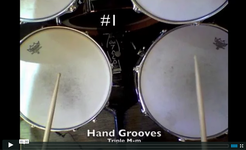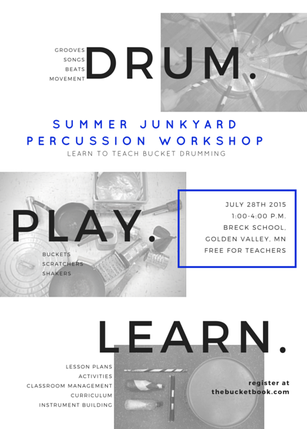Summer has finally arrived. Here in Minnesota, that means we are guaranteed at least 3 weeks of sunshine before it starts to snow again.
If you are like me, during the school year you mentally keep a list of things you want to incorporate or improve in your teaching. Kind of a “music teaching related things I want to do but don’t have time to focus on because the school year is so crazy, so I’ll optimistically plan to do them this summer” type of list. And if you teach K-12 general music, you invariably teach drumming of some sort during the year, so maybe you want to be a better drum teacher to your students come this fall.
I’m good at making the list, but I’m less good at following through with all the goals on it during the summer. If getting more comfortable with percussion is one of your goals this summer, I’m here to help. Here are 5 free resources to improve your comfort level with drumming.
1. Play this. Get a pair of sticks, something to hit (a drum, phone book, pillow, mouse pad) and play along with this video.
If you are like me, during the school year you mentally keep a list of things you want to incorporate or improve in your teaching. Kind of a “music teaching related things I want to do but don’t have time to focus on because the school year is so crazy, so I’ll optimistically plan to do them this summer” type of list. And if you teach K-12 general music, you invariably teach drumming of some sort during the year, so maybe you want to be a better drum teacher to your students come this fall.
I’m good at making the list, but I’m less good at following through with all the goals on it during the summer. If getting more comfortable with percussion is one of your goals this summer, I’m here to help. Here are 5 free resources to improve your comfort level with drumming.
1. Play this. Get a pair of sticks, something to hit (a drum, phone book, pillow, mouse pad) and play along with this video.
When you are bored with that one, move on to these:
Goal: Make your hands work better when playing with sticks. This will help you identify poor technique in your students and help to diagnose when technique is interfering with rhythm and vice versa.
2. Read a book.
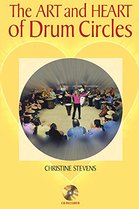
The Art and Heart of Drum Circles by Christine Stevens is a great book that introduces how to be a drum circle facilitator, which is essentially
what we are when we teach drumming in the classroom. Lots of activity
ideas and suggestions for improving ensemble playing.
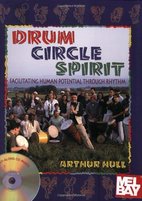
Drum Circle Spirit: Facilitating Human Potential through Rhythm by Arthur Hull Another solid drum circle book. Hull does a good job blending the practical with the philosophical. Written in a story telling voice and super cheap on Amazon right now ($0.49)
3. Find other people to drum with. Attend a workshop like the well regarded World Music Drumming, my own Summer Junkyard Percussion Workshop (100% free) or simply find other percussionists to play with. Could be a drum circle in a park, a Brazilian drumming class or just some friends jamming in a basement.
Goal: be able to lock into a groove with other people, so you can help your students do the same.
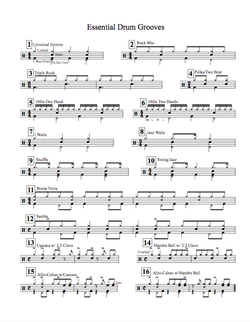 Click to Download PDF
Click to Download PDF
4. Increase your coordination.
Find a friend with a drum set and have them teach you something. Better yet, print out this set of essential drum grooves and learn a few.
Goal: Make your arms and legs get along with each other. This will increase your empathy for your students who have trouble marching to a steady beat or getting their hands to work properly. Also as a bonus, when you drum in class with only your hands, it’ll seem like a piece of cake.
Find a friend with a drum set and have them teach you something. Better yet, print out this set of essential drum grooves and learn a few.
Goal: Make your arms and legs get along with each other. This will increase your empathy for your students who have trouble marching to a steady beat or getting their hands to work properly. Also as a bonus, when you drum in class with only your hands, it’ll seem like a piece of cake.
5. Listen to excellent drummers. Here is a youtube playlist of great drumming. Listen without any goals or expectations, just absorb and enjoy what really excellent drumming sounds like.
Some things to listen for:
Olodum: No group of drummers groove harder than this group from Bahia.
Clyde Stubblefield and John Starks: These two set the standard for funky drumming.
John Bonham: This wild video shows a human being who was born to play the drums.
Giovanni Hildalgo: His playing is very melodic here.
Max Roach: Known for innovating/creating bop drumming. He shows that 3/4 can groove and also be melodic.
Chris Dave: Incredible fast hands and deep groove.
Steve Smith: Another example of a natural born drummer. Believe it or not, he was the drummer for Journey.
Goal: Learn to hear the difference between “good” and “great” drumming. Then you can help your own students improve.
Olodum: No group of drummers groove harder than this group from Bahia.
Clyde Stubblefield and John Starks: These two set the standard for funky drumming.
John Bonham: This wild video shows a human being who was born to play the drums.
Giovanni Hildalgo: His playing is very melodic here.
Max Roach: Known for innovating/creating bop drumming. He shows that 3/4 can groove and also be melodic.
Chris Dave: Incredible fast hands and deep groove.
Steve Smith: Another example of a natural born drummer. Believe it or not, he was the drummer for Journey.
Goal: Learn to hear the difference between “good” and “great” drumming. Then you can help your own students improve.
How are you planning to improve as a teacher this summer? Post your plans in the comments and don't forget to subscribe to the blog for email updates with helpful stuff throughout the entire year.

